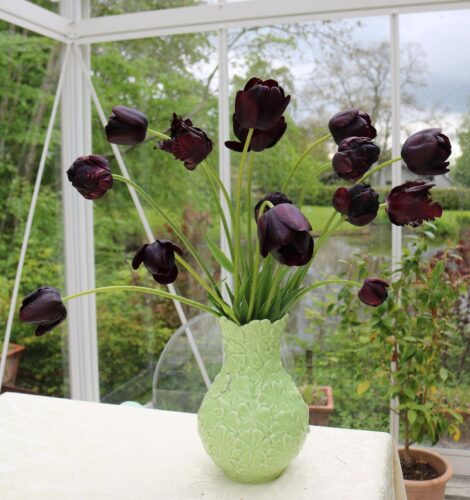Follow this Queen of the Night Tulip Care and Growing Guide for adding a pop of color to your flower bed with these beautiful blooms.
Queen of the Night Tulip can be a beautiful addition to the borders, containers, and garden beds. Read all the information that help you grow this colorful bloom in your yard.
USDA Zones: 3-8
Read night-blooming-jasmine care HERE
Queen of the Night Tulip Information

Also known as Black Queen Tulip, Queen of the Night Tulip (Tulipa Queen of the Night) belongs to the Liliaceae family. This perennial bulbous plant displays velvety dark purple or maroon flowers that look almost black. It is a member of a single late tulip group that has received the Award of Garden Merit of the Royal Horticultural Society.
This exotic plant can be grown anywhere in cool winters and warm summers. It can be a great addition to garden beds, containers, and borders. It can grow up to 2-3 feet tall.
Read the tips to make Christmas cactus bloom
How to Propagate Queen Of The Night Tulip
- Plant Queen Of The Night Tulip during fall, 6-8 weeks before the first frost.
- Propagate the bulbs 6-8 inches deep in the soil, and keep the pointed end up of the bulb in the hole. Cover it with soil and press gently.
- The ideal spacing of bulbs will be 4-6 inches apart.
- While growing this tulip as a perennial, feed the bulbs with bone meal.
- Do not water the bulbs after planting if there is rain in the fall, as too much water can be harmful. Whereas in dry periods, water the bulbs once a week till the first frost.
- Once leaves develop, apply bone meal or bulb food during spring. Also, add compost after flowering so they’ll continue to come again next year.
Explore love-in-a-mist meaning HERE
Ideal Growing Conditions for Queen Of The Night Tulip

Light
Choose a spot with full sun for growing queen of the night tulip in your garden, where it gets a minimum of 6-8 hours of direct sunlight daily.
Soil
Grow queen of the night tulip in sandy soil as it allows sufficient air-circulation to the roots of the plant. Add compost to make the soil nutrient-rich. Also, keep the pH range neutral to acidic, such as 6.0-7.0.
Water
Keep the soil moist but not waterlogged. Water the plant twice in hot weather, whereas decreasing the frequency in winter by watering once a week.
To avoid waterlogged soil conditions, check the soil moisture before watering. Insert your index finger in the soil; if it comes out dry, it’s time to hydrate your plant.
Temperature and Humidity
Queen of the Night Tulip grows well in areas with cool winters and warm summers. It needs 12-14 weeks of temperature under 55 F for flowering. Hence, in zones with warm winter temperatures, grow tulips as annuals and buy from vendors who prechill the bulbs.
Moreover, tulips perform better in dry areas compared to humid climates, as most of the time, high humidity comes side-by-side with spring and summer rain, which leads to bulb rot.
Explore Jacquemontia Pentanthos Care Guide HERE
Queen Of The Night Tulip Care

Fertilizer
While planting the bulbs, add bone meal or compost to the planting hole.
Feed the tulip once a year in the fall. Apply a slow-release fertilizer in the ratio of 9-9-6. Fertilize your tulip plant at the top of the soil.
Pruning
While growing queen of the night tulip as perennial, cut back the flower stalk just after the flowering to prevent the plant from generating the seed pods. This is required as they discharge the energy of the bulb and reduce its lifespan.
To restore the energy of bulbs, keep the foliage in position until it becomes pale during mid-to-late summer.
Overwintering
While growing in cold winter regions, tulips in the garden need no winter protection. However, hold back watering in fall, as wet soil can lead to bulb rot.
If you have started new plants from seed in pots during spring, protect them in a cold frame for the first outdoor winter exposure.
Pests and Diseases
Squirrels, deer, and rodents can be a threat to tulip bulbs and foliage. You can protect them by planting tulips in pots, or using repellents are a good solution. Companion planting with daffodils also works.
Pests such as aphids, bulb mites, and thrips can harm the plant. Deter aphids by using a water spray or hand-pick them. Deter bulb mites by soaking the bulbs for 2-minutes in 120-degree water. Use sticky traps or bring ladybugs as predatory insects to get rid of thrips.
Tulips are vulnerable to fire fungus and basal rot. Fire fungi result in deformed plants that do not develop. The affected plants feature dark rings or curling shoots. Use fungicide and discard the affected bulbs.
Plants affected by basal rot develop dark brown spots or pink/white fungus on the bulbs. Reject the infected bulbs and replace the plants with new bulbs, cured with fungicide.



